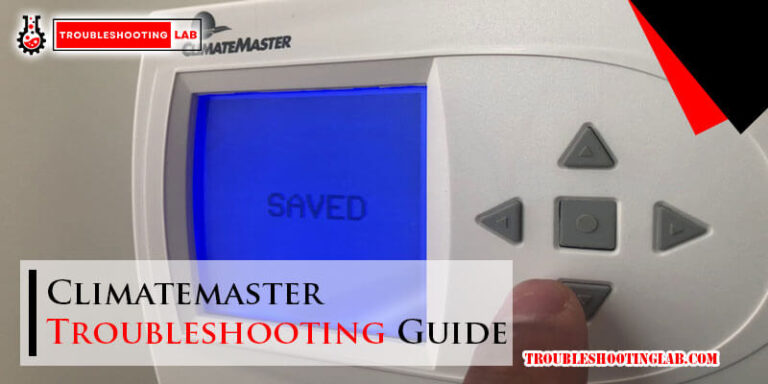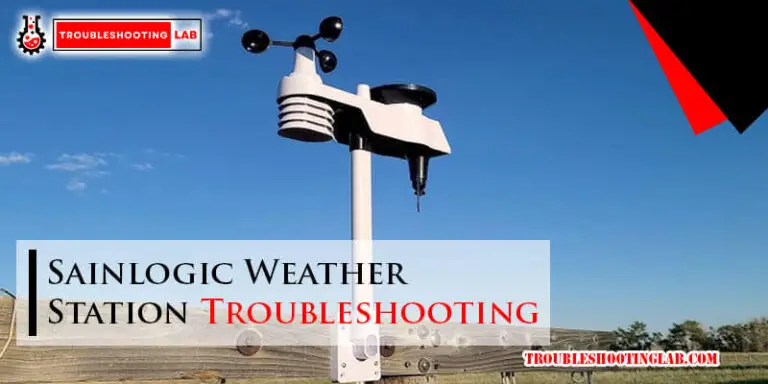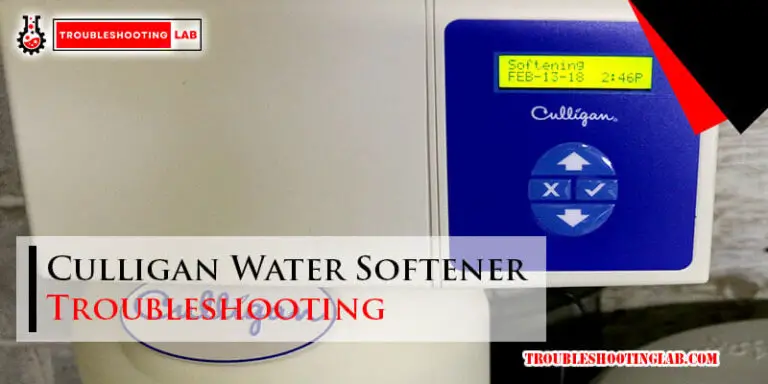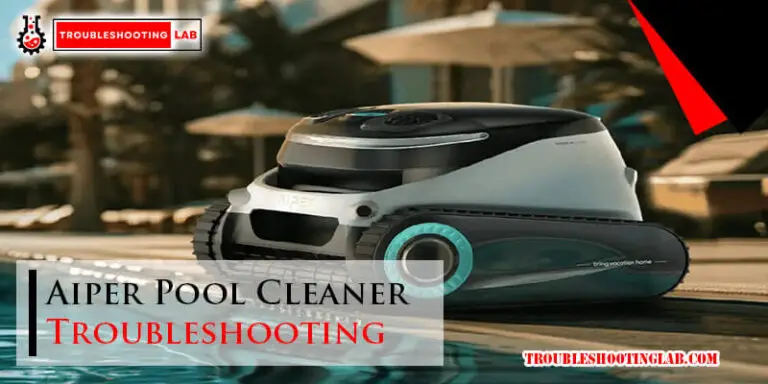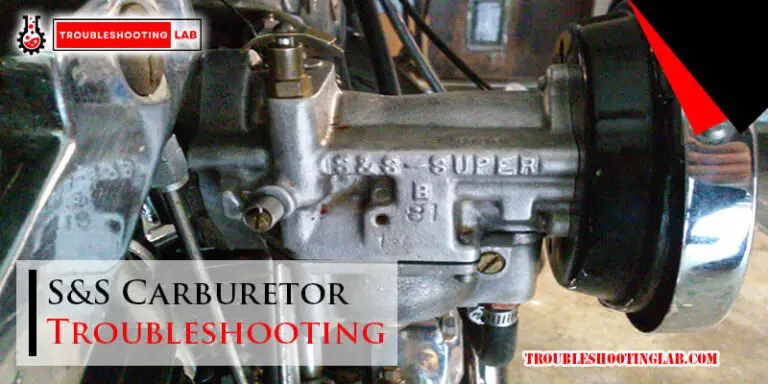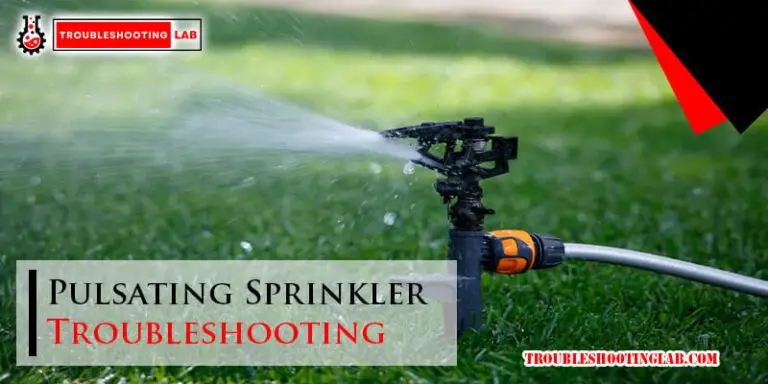Polaris Pool Cleaner Troubleshooting: Expert Tips & Tricks
If your Polaris Pool Cleaner is not moving or only moving in one spot, try unplugging and securely plugging the cable back into the control unit. If that doesn’t work, reset the cleaner’s cycle by turning it off and back on, then selecting a new cycle.
Another common issue is the internal tubing becoming disconnected, which can be fixed by checking and reconnecting the tubing inside the cleaner. Additionally, low flow can cause the cleaner to not pick up debris, so make sure to empty the pump and skimmer baskets and backwash the filter.
By following these troubleshooting steps, you can easily fix common issues with your Polaris pool cleaner.

Common Issues With Polaris Pool Cleaner
Polaris Pool Cleaner Not Moving Or Only Moving In One Spot
If you notice that your Polaris Pool Cleaner is not moving at all or only staying in one spot, there could be a few possible reasons for this issue. First, check if the swivels in the hoses are leaking. If the swivels are leaking more than a steady drip, they may need to be replaced. Additionally, the water tubes inside the cleaner may have become disconnected, reducing the internal pressure and causing the cleaner to stop moving. Open up the cleaner and ensure all the internal tubing is correctly connected.
Polaris Pool Cleaner is Picking Up Debris Effectively
If your Polaris Pool Cleaner is not effectively picking up debris, there are a few troubleshooting steps you can take. Firstly, check the debris collection bag or canister to ensure it is properly attached and not clogged with debris. Clean out any debris and reattach the bag securely. Additionally, check the filter screen inside the cleaner to make sure it is clean and free from any obstructions. Lastly, check the water flow and pressure of your pool pump to ensure it is operating at the correct level for optimal cleaning performance.
Polaris Pool Cleaner Getting Stuck On Obstacles
If your Polaris Pool Cleaner is constantly getting stuck on obstacles in your pool, there are a few potential solutions. Firstly, check the wheels and brushes of the cleaner to ensure they are not worn out or damaged. Replace any worn-out parts as necessary. Additionally, adjust the thrust jet on the cleaner to provide more power and help it navigate around obstacles. Lastly, check the hose length and position to ensure it is not getting tangled or caught on any pool equipment.
Polaris Pool Cleaner Hose Tangling Or Twisting
If you find that the hose of your Polaris Pool Cleaner is constantly tangling or twisting during operation, it can disrupt the cleaning process. To resolve this issue, consider using a hose swivel to prevent tangling. Additionally, check the length of the hose and make sure it is correctly positioned to allow for smooth navigation around the pool. Straightening out any kinks or loops in the hose can also help prevent tangling.
Polaris Pool Cleaner Not Turning On Or Operating
If your Polaris Pool Cleaner is not turning on or operating, there are a few steps you can take to troubleshoot the issue. Firstly, check the power supply and ensure that the cleaner is securely plugged in. If there is no power, check the circuit breaker or fuse box to ensure that power is reaching the outlet. If the power supply is not the issue, check the control unit of the cleaner for any error codes or flashing indicator lights. Refer to the user manual or contact the manufacturer for specific troubleshooting steps based on the error code displayed.
1. Checking The Backup Valve
To ensure that your Polaris pool cleaner is functioning properly, it is important to regularly inspect the backup valve. The backup valve is responsible for the random movements of the cleaner, allowing it to clean your pool effectively. By checking the backup valve, you can identify any issues and take appropriate steps to resolve them.
How To Inspect The Backup Valve
To inspect the backup valve, follow these simple steps:
- Turn off the pool pump
- Remove the cleaner from the pool
- Locate the backup valve, which is usually positioned on the hose near the cleaner head
- Inspect the backup valve for any visible signs of wear or damage
- Check the internal mechanism of the backup valve to ensure it is moving freely
Signs Of A Faulty Backup Valve
Several signs may indicate a faulty backup valve:
- The cleaner is moving in a pattern or staying in one spot
- The cleaner is not making random movements
- There is a decrease in the overall cleaning performance of the cleaner
- There are visible leaks or cracks on the backup valve
Steps To Replace The Backup Valve If Necessary
If you have determined that the backup valve needs to be replaced, follow these steps:
- Turn off the pool pump
- Remove the cleaner from the pool
- Disconnect the backup valve from the hose
- Replace the faulty backup valve with a new one
- Reconnect the backup valve to the hose
By regularly checking the backup valve and addressing any issues promptly, you can ensure that your Polaris pool cleaner continues to operate efficiently, keeping your pool clean and inviting.
2. Examining The Rear Float
The rear float is an essential component in the operation of your Polaris pool cleaner. It not only helps the cleaner maintain proper balance and stability but also prevents it from getting stuck on obstacles or the pool floor. If you are experiencing any issues with your Polaris pool cleaner, examining the rear float should be your next step in troubleshooting.
Importance Of The Rear Float In The Pool Cleaner’s Operation
The rear float plays a crucial role in ensuring the smooth operation of your Polaris pool cleaner. Its primary purpose is to keep the cleaner’s rear end buoyant, enabling it to maneuver efficiently and avoid obstacles. The rear float makes sure that the cleaner stays at the optimal depth in the water, allowing it to effectively clean the pool’s surface and walls.
How To Troubleshoot Issues With The Rear Float
If you are experiencing issues with your Polaris pool cleaner, the rear float could be the culprit. Here are some common problems to look out for:
- Float is damaged or leaking
- Float is disconnected or misaligned
- Float is dirty or clogged with debris
To troubleshoot these issues, follow these steps:
- Inspect the rear float for any visible signs of damage or leaks. If you notice any cracks or holes, the float will need to be replaced.
- Ensure that the float is securely connected to the cleaner. If it is loose or misaligned, adjust it to its proper position.
- Clean the float thoroughly, removing any debris or obstructions that may be affecting its performance. Rinse it with water and use a brush if necessary.
Steps To Fix Or Replace A Faulty Rear Float
If you have determined that the rear float is indeed faulty and needs to be fixed or replaced, follow these steps:
- Turn off the Polaris pool cleaner and disconnect it from the power source.
- Remove the rear float by gently pulling it off the cleaner.
- If the float is damaged, order a replacement from an authorized Polaris dealer or manufacturer.
- Attach the new float to the cleaner, ensuring it is securely in place.
- Once the float is properly installed, reconnect the Polaris pool cleaner to the power source and test its operation.
By examining the rear float and addressing any issues, you can ensure that your Polaris pool cleaner operates efficiently and effectively, keeping your pool clean and inviting.
3. Optimizing Run Time And Pool Pump Integration
Optimizing the run time of your Polaris Pool Cleaner is crucial for efficient cleaning and preventing excessive wear and tear. The ideal run time for your Polaris Pool Cleaner depends on factors such as the size of your pool, the level of debris, and the manufacturer’s recommendations. To determine the ideal run time:
- Start with a baseline run time of about two hours a day.
- Observe how clean your pool is after each cleaning cycle.
- If your pool requires additional cleaning, gradually increase the run time by 15-minute increments until the desired level of cleanliness is achieved.
- Keep in mind that running the cleaner for too long may result in unnecessary energy consumption while running it for too short a time may leave your pool dirty.
Synchronizing your Polaris Pool Cleaner with the pool pump ensures optimal performance and efficiency. Here’s how to sync them:
- Turn off the pool pump and Polaris Pool Cleaner.
- Locate the pressure relief valve on the pool pump, usually found near the pool filter.
- Slowly open the pressure relief valve to release any trapped air.
- Once the air is released, close the pressure relief valve tightly.
- Turn on the pool pump and wait for it to reach full operational pressure.
- Turn on the Polaris Pool Cleaner and ensure that the hose is properly connected to both the cleaner and the pool skimmer or dedicated cleaner line.
- Observe the cleaner’s movement and adjust the flow control valve if necessary to achieve optimal navigation.
If you are experiencing insufficient run time or issues with the integration of your pool pump and Polaris Pool Cleaner, consider the following troubleshooting tips:
- Check for any leaks or blockages in the cleaner’s hoses and connections, as this may affect proper water flow.
- Ensure that the pool pump is operating at the recommended pressure, as specified by the manufacturer.
- If you notice any unusual noises or vibrations, inspect the impeller and filter for debris that may be affecting the pump’s performance.
- Verify that the pressure relief valve is functioning correctly and that there are no air leaks in the system.
- If the cleaner is not moving or only moving in one spot, check the swivels in the hoses for leaks and replace them if necessary.
- Make sure all internal tubing in the cleaner is connected properly to maintain sufficient pressure for movement.
By optimizing the run time of your Polaris Pool Cleaner and ensuring proper integration with the pool pump, you can enjoy a sparkling clean pool with minimal effort. Regular troubleshooting and maintenance will help extend the life of your cleaner and enhance its performance.
4. Understanding Pressure Relief
Pressure relief plays a crucial role in the proper functioning of a pool cleaner. It helps maintain the necessary pressure needed for effective cleaning while preventing damage to the equipment. In this section, we will discuss the importance of pressure relief, how to troubleshoot and fix pressure relief issues, and steps to maintain proper pressure in your Polaris pool cleaner.
Importance Of Pressure Relief In The Pool Cleaner
Pressure relief in a pool cleaner is essential for several reasons. Firstly, it ensures that the cleaner operates at an optimal level, providing efficient and thorough cleaning. If the pressure becomes too high, it can strain the cleaner’s components, leading to premature wear and tear.
Secondly, pressure relief helps prevent any blockages or clogs in the pool cleaner’s hoses or other parts. If the pressure is not properly regulated, debris may accumulate, causing the cleaner to become less effective or even stop working altogether.
To maintain the longevity of your Polaris pool cleaner and ensure effective cleaning, it is crucial to understand how to troubleshoot and fix any pressure relief issues that may arise.
How To Troubleshoot And Fix Pressure Relief Issues
If you notice that your Polaris pool cleaner is not functioning as it should or is experiencing pressure-related problems, follow these steps to troubleshoot and fix the issue:
- Check the pool cleaner’s filter screen: A clogged or dirty filter screen can restrict water flow and cause pressure issues. Clean or replace the filter screen if necessary.
- Inspect the cleaner’s hose connections: Ensure that all the hoses are firmly attached and free from any leaks or cracks. Any air leaks can affect the pressure inside the cleaner.
- Check the pool pump’s performance: A weak or malfunctioning pool pump can lead to insufficient pressure. Make sure the pump is running at its optimal capacity and address any issues with the pump if necessary.
- Examine the pressure relief valve: The pressure relief valve is responsible for regulating the pressure inside the cleaner. If it is not functioning correctly, it may need to be replaced.
By troubleshooting and fixing pressure relief issues promptly, you can ensure that your Polaris pool cleaner operates at its best and delivers the desired cleaning results.
Steps To Maintain Proper Pressure In The Pool Cleaner
To maintain proper pressure in your Polaris pool cleaner and prevent pressure-related problems, follow these steps:
- Regularly clean and maintain the pool cleaner’s filter screen to ensure optimal water flow.
- Check for any air leaks or damage in the hoses and promptly repair or replace them if needed.
- Keep a close eye on the pool pump’s performance and address any issues promptly to maintain sufficient pressure.
- Periodically inspect and clean the pressure relief valve to ensure it functions properly.
By following these steps, you can maintain proper pressure in your Polaris pool cleaner and enjoy clean and clear pool water.
5. Ensuring Proper Hose Length
The Significance Of Hose Length In The Pool Cleaner’s Performance
Ensuring the proper hose length for your Polaris pool cleaner is crucial for optimal performance. The length of the hose directly affects the cleaner’s ability to reach all areas of the pool and effectively remove debris. A hose that is too short may restrict movement and leave certain areas untouched, while a hose that is too long can lead to tangling and decreased efficiency. Therefore, it is essential to determine the correct hose length for your specific pool.
How To Determine The Correct Hose Length For Your Pool
Determining the correct hose length for your Polaris pool cleaner is a relatively simple process. Start by measuring the distance from your pool’s skimmer to the furthest point from the skimmer, typically the opposite end. Add a few extra feet to this measurement to account for any obstacles or corners that the cleaner may need to navigate. This extra length will ensure that the cleaner can move freely without restrictions.
Once you have determined the appropriate hose length, you can easily customize your Polaris pool cleaner’s hose to match your pool’s dimensions. Most Polaris cleaners come with sections of hose that can be added or removed to achieve the desired length. Simply connect or disconnect these sections as needed to achieve the optimal hose length for your pool.
Tips For Managing And Preventing Hose Curling Or Tangling
To maintain efficient and trouble-free operation, it’s crucial to manage and prevent hose curling or tangling. Here are some tips to help you:
- Proper storage: Store your Polaris pool cleaner’s hose in a straight and untangled position when not in use. This helps prevent unwanted curling or tangling during storage and makes it easier to attach the hose when it’s time to clean the pool.
- Hose float position: Ensure that the float on the Polaris cleaner’s hose is properly positioned. The float should be placed approximately six inches away from the cleaner to prevent it from tangling with the hose.
- Regular inspections: Periodically inspect the hose for any signs of wear or damage. Replace any worn-out or damaged sections to prevent further issues.
- Adjusting water flow: Adjusting the water flow from the pool’s filtration system can help reduce hose curling or tangling. Experiment with different flow rates to find the optimal setting for your specific pool and cleaner.
By adhering to these tips and ensuring proper hose length, you can troubleshoot and prevent common issues associated with Polaris pool cleaners. Taking the necessary precautions will optimize your cleaner’s performance and keep your pool clean and debris-free.
Additional Tips And Tricks For Polaris Pool Cleaner Maintenance
Proper cleaning and maintenance routine for the Pool Cleaner:
- Regularly clean the filter bag or canister to ensure optimal suction power and prevent debris from clogging the cleaner.
- Inspect the wheels, brushes, and other moving parts for any signs of wear or damage. Replace any worn-out components to avoid performance issues.
- Check the hose for any kinks, twists, or leaks. Straighten out any kinks and repair or replace any damaged sections of the hose.
- Ensure that the pool pump and filtration system are in good working condition. A well-functioning pump and clean filter will enhance the overall performance of the pool cleaner.
- Properly store the pool cleaner when not in use to protect it from harsh weather conditions and prolong its lifespan.
How To Avoid Common Problems And Prolong The Lifespan Of The Pool Cleaner:
- Always check and clean the impeller to ensure it is free from debris. A clogged impeller can result in reduced suction and poor cleaning performance.
- Regularly inspect and clean the backup valve to prevent blockages that may hinder the cleaner’s movement.
- Avoid operating the pool cleaner when the pool water is below 40°F (4°C) as freezing temperatures can damage internal components.
- Ensure that the pool cleaner is not running when chemical shock treatments are being performed. Chemicals can damage the cleaner’s mechanisms.
- Properly balance the pool water chemistry to prevent the buildup of algae and other debris that can clog the cleaner or cause other performance issues.
Recommended Troubleshooting Resources And Support Options:
If you encounter any issues with your Polaris pool cleaner, these resources can provide helpful troubleshooting tips and support:
- Visit the official Polaris website for troubleshooting guides and FAQs specific to your model: https://www.polarispool.com/
- Contact Polaris customer support via phone or email for further assistance with troubleshooting and maintenance:
- Phone: 1-800-822-7933
- Email: support@polarispool.com
- Consult online forums and communities where pool owners share their experiences and solutions to common pool cleaner issues.
- Watch instructional videos on platforms like YouTube that provide step-by-step troubleshooting guides for Polaris pool cleaners.
Frequently Asked Questions
How Do I Reset My Polaris Pool Cleaner?
To reset your Polaris pool cleaner, follow these steps: 1. Unplug the cable from the control unit. 2. Securely plug the cable back in. 3. If the problem persists, turn off the cleaner and turn it back on. 4. Select a new cleaning cycle.
This should resolve any flashing indicator lights or error codes on the display screen. Make sure to troubleshoot other issues like disconnected tubing or low flow if necessary.
Why Does My Polaris Pool Cleaner Stay In One Spot?
Your Polaris pool cleaner staying in one spot could be due to a few reasons. Firstly, check if the swivels are leaking, as this can affect movement. If they are leaking more than a steady drip, they may need to be replaced.
Secondly, ensure that all internal tubing is connected properly, as disconnected tubes can reduce pressure and cause the cleaner to stop moving.
Why Did My Polaris Pool Cleaner Stop Working?
If your Polaris pool cleaner has stopped working, it could be due to disconnected water tubes inside the cleaner, which reduces internal pressure. Check all the internal tubing to make sure it is properly connected. If the cleaner is not picking up debris, it may be due to low flow, so empty your pump and skimmer baskets and backwash your filter.
Why Is My Polaris Not Picking Up Debris?
Your Polaris may not be picking up debris due to low flow. Check and empty your pump and skimmer baskets, and backwash your filter. Also, make sure the screen on the Polaris wall fitting is not clogged.
Why Is My Polaris Cleaner Not Moving Or Only Moving In One Direction?
If your Polaris cleaner is not moving or moving in only one direction, try unplugging the cable from the control unit and securely plugging it back in. If the issue persists, reset the cleaner by turning it off and back on, then select a new cleaning cycle.
Conclusion
Troubleshooting your Polaris pool cleaner doesn’t have to be a daunting task. By following the simple steps outlined in this blog post, you can quickly identify and resolve common issues like a cleaner that won’t move or isn’t picking up debris.
Remember to check for leaks, ensure proper tube connections, and maintain good water flow. By addressing these problems promptly and effectively, you can keep your pool clean and enjoy a hassle-free swimming experience all season long.

